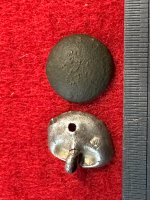Glen's Loyalists
Full Member
- Jan 7, 2024
- 108
- 440
I have been going thru a few bags of finds from our old farm and came across a few items I am curious about, perhaps someone has some ideas.
First up is this heavy copper item. The patina is absolutely amazing, a heavy and almost perfect apple green. This has been in the ground for a long time.


You can see that the edges have been hammered




Broken at both ends, the breaks do not match, and I do not see that this ring has been bent. To my eye, this is exactly the shape in which it was made, I don't think it has been bent or twisted in the ground.

At first we thought it might be a broken reigns guide but the metal is far too good. There is no pitting or degradation, it is very heavy and very very smooth. It has been hammered into shape. It is a really nice, tactile object, whatever it is. There has been natives in the area for centuries.
Any ideas?
Next is this nice buckle. This site dates to the 1780's, but this feels later. There have been a lot of Naval & military finds on this property, mainly from the War of 1812 period, and I believe the militia practiced here up until the 1860's. A number of finds date to the mid 18th century or earlier. Prior to the 1780's the British Navy used the Tudor rose as an emblem and I am wondering if this could possibly be a buckle from that era. I very much doubt it, but thought I would ask the question. Does anybody have any info on Tudor Rose Buckles?


One the right below is a mid 18th century British Military blow hole button, you can just see the crown outline in the center. I would think this dates to mid to later George II era, pre 1760's from what I have read. What we are wondering about is the silver item. I say blow hole button, my son say little bell or perhaps acorn button. The mark appears to be an M, the closest I saw for an M in that shape was for Edinburgh 1716. That would fit, I think, for a blow hole and there are lots of Scottish finds about. Any thoughts one this one?


One of the more interesting nails that I have found. This was not a door nail, and the end has been flattened. And I don't think that it would work well as a pipe tamper. Mystery to me.

This is also a mystery to me. The script is old. How I wish I knew what it was from. It appears that it would have been conical, whatever it wrapped.

I'd be interested to hear your thoughts.
First up is this heavy copper item. The patina is absolutely amazing, a heavy and almost perfect apple green. This has been in the ground for a long time.
You can see that the edges have been hammered
Broken at both ends, the breaks do not match, and I do not see that this ring has been bent. To my eye, this is exactly the shape in which it was made, I don't think it has been bent or twisted in the ground.
At first we thought it might be a broken reigns guide but the metal is far too good. There is no pitting or degradation, it is very heavy and very very smooth. It has been hammered into shape. It is a really nice, tactile object, whatever it is. There has been natives in the area for centuries.
Any ideas?
Next is this nice buckle. This site dates to the 1780's, but this feels later. There have been a lot of Naval & military finds on this property, mainly from the War of 1812 period, and I believe the militia practiced here up until the 1860's. A number of finds date to the mid 18th century or earlier. Prior to the 1780's the British Navy used the Tudor rose as an emblem and I am wondering if this could possibly be a buckle from that era. I very much doubt it, but thought I would ask the question. Does anybody have any info on Tudor Rose Buckles?
One the right below is a mid 18th century British Military blow hole button, you can just see the crown outline in the center. I would think this dates to mid to later George II era, pre 1760's from what I have read. What we are wondering about is the silver item. I say blow hole button, my son say little bell or perhaps acorn button. The mark appears to be an M, the closest I saw for an M in that shape was for Edinburgh 1716. That would fit, I think, for a blow hole and there are lots of Scottish finds about. Any thoughts one this one?
One of the more interesting nails that I have found. This was not a door nail, and the end has been flattened. And I don't think that it would work well as a pipe tamper. Mystery to me.
This is also a mystery to me. The script is old. How I wish I knew what it was from. It appears that it would have been conical, whatever it wrapped.
I'd be interested to hear your thoughts.





